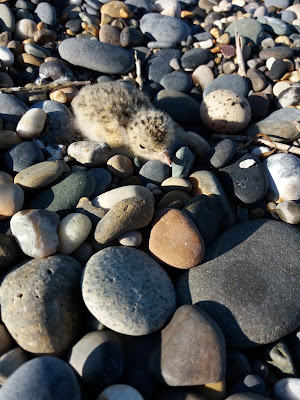Apologies to our followers for the lack of updates recently; the past couple of weeks have been hectic to say the least! The season is coming to a close, with 24/hr monitoring of the colony no longer in practice as the wardens are packing up. Most of the fencing has been taken down and put into storage, and numbers of Little Terns have been gradually depleting as they embark on their journey home. The last active nest of the season, K195, has hatched one chick successfully, so we're hoping this little dude will catch up with its peers.
 |
| The last little floof of the season beside the final egg of the season (which sadly, did not hatch). Photo taken under NPWS licence (I. Sullivan). |
Though this chick is at a disadvantage having hatched this late into July, Little Tern chicks grow incredibly fast, packing on the grammes and milimetres to fledge in just under a month (25-28 days). Following some serious gainz, the chicks begin to grow their pins, developing wings capable of the great flight home. Parent Little Terns definitely deserve a pat on the wing for providing all the sprats, sandeels, gobies and more necessary to satiate the appetite of their chicks.
 |
| This older chick is really concentrating on wing development.. look at that unbroken gaze. Photo taken under NPWS licence (I. Sullivan). |
 |
| A sketch of the right wing of the chick featured in the photo above. (I. Sullivan). |
 |
| The wing of a fledgling. Notice the loss of yellow down, replaced by sturdy grey wings which have yellow and blue-green tones in the covert plumage. (I. Sullivan). |
Recently, we were delighted to welcome a really wonderful enthusiastic group of after-schoolers from Little Harvard Creche & Montessori. A fantastic time was enjoyed by all, and we wardens are so chuffed to receive your artworks (Thank you!). I think this collage perfectly captures the essence of the Little Tern:
 |
| ~Little Harvard-Little Tern Collaboration, 2017.~ |
We would also like to extend our gratitude to David and Barbara at "Wicklow People." Last week's edition of the newspaper featured an outstanding piece on the work carried out by the Little Tern Conservation Project. It's really great when the efforts carried out to protect the Little Terns are publicised in local media.
You can read their article about the Kilcoole Little Tern Project here.
You can read their article about the Kilcoole Little Tern Project here.
There appears to be no rest for the wardens despite the season coming to an end, as a local Sparrowhawk has taken to agitating the colony over the past couple of weeks. Though continually chased and mobbed by the terns and wardens alike, this bird of prey could pose a major threat to remaining fledglings and the few young chicks left on the foreshore. Though we're packing up here at Kilcoole, there is still a significant number of terns around - I counted between 20 and 30 today. Therefore, it is vital we continue to respect their presence on the beach as the fencing is removed.
We would like to extend a massive thanks to all beach users for continuing to ensure the Little Terns aren't disturbed.
Until next time,
Irene and the Kilcoole Team




